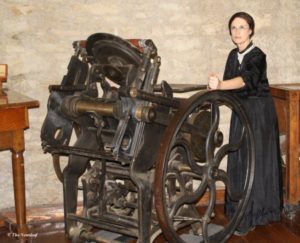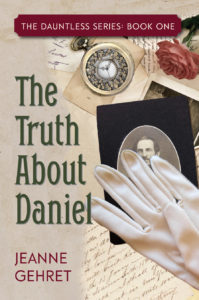Jeanne Gehret's Blog: http://SusanBAnthonyFamily.com/, page 13
January 12, 2017
Rustling Horses in Huron, KS
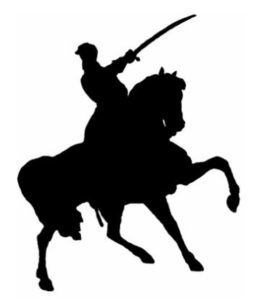 D.R. Anthony had many financial irons in the fire–early investment in Kansas land, political appointments, the insurance business, and a newspaper business that became a family dynasty. But more than once he was accused of horse stealing, and he openly told family that he had “liberated” steeds during his jayhawker raids on Missouri.
D.R. Anthony had many financial irons in the fire–early investment in Kansas land, political appointments, the insurance business, and a newspaper business that became a family dynasty. But more than once he was accused of horse stealing, and he openly told family that he had “liberated” steeds during his jayhawker raids on Missouri.
This guest post discusses his large stock farm that adjoined lands owned by his sisters Mary and Susan.
—
The Anthony Stock Farm in Huron, Kansas
For many years The D.R. Anthony family owned the property known as the Anthony Stock Farm or Ranch west of Huron, Kansas, north of Leavenworth County, in neighboring Atchison County. Originally, the property was part of a land grant from U.S. President James Buchanan to Col. Daniel R. Anthony, who purchased it at a sale of the Delaware Indian lands in Osawki, Kansas, in May 1856. He paid $1.75 per acre and agreed, as did other buyers, to improve the land, build a house and live there a certain number of days each month. Col. Anthony bought four quarters for himself and one quarter each for his sisters, Susan B. Anthony and Mary S. Anthony. Years later, the Anthony family noted that all three built cabins and resided on their farms the required amount of time.
Col. Anthony donated part of his land for the town of Huron (named after the Huron tribe of Indians), platted in April 1882 and later deeded 20 acres to the railroad, which made Huron an important shipping and supply community.
Initially operated as a livestock farm, horses and cattle were kept on the ranch. The Anthonys came often to ride the horses, first by horse and buggy and later on the train from Leavenworth. The property was also utilized by the Cavalry from Fort Leavenworth, on their way to Fort Crook, Nebraska.
In 1888, Col. Anthony had a lithograph of his magnificent farm distributed to Kansas newspapers. One commented that the bird’s eye view of the ranch showed “that the colonel knows how to lay out and improve a farm –and make it pay, too—as well as conduct a first class newspaper. If ‘Farmer’ Anthony gets the nomination for the governorship, he will be enthusiastically supported by his fellow farmers.” DR’s desire to become Governor of Kansas was never realized.
(The lithograph will appear in the next post along with part two of this article.)
This post courtesy of Mary Ann Sachse Brown
January 10, 2017
Susan B. Anthony and the Freedom of the Press
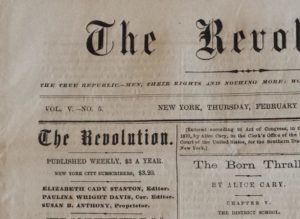 From the time she was a teenager, Susan B. Anthony hated writing. Early in her public life she lamented, “Whenever I take a pen in hand I seem to be mounted on stilts.” It is ironic, therefore, that she left behind a literary legacy that included two years of a weekly newspaper, the four-volume set of The History of Woman Suffrage, and her three-volume authorized biography.
From the time she was a teenager, Susan B. Anthony hated writing. Early in her public life she lamented, “Whenever I take a pen in hand I seem to be mounted on stilts.” It is ironic, therefore, that she left behind a literary legacy that included two years of a weekly newspaper, the four-volume set of The History of Woman Suffrage, and her three-volume authorized biography.
Despite her struggles with writing, she also became famous for giving thousands of speeches on antislavery, the restriction of alcoholic beverages, and the necessity of women’s rights.
To overcome her aversion to writing, Anthony collaborated. From the beginning of her friendship with Elizabeth Cady Stanton, Anthony gathered materials for her silver-tongued friend to turn into prose. Then Anthony had the speeches and articles published and circulated. As time went on, Stanton mentored her friend so well that Anthony was able to make and deliver her own speeches, as well.
It’s likely that Susan learned about publishing when she visited her brother Daniel (D.R.), who owner a newspaper in Leavenworth, KS. During that period D.R. needed time to run his mayoral campaign, so Susan stepped in to run his newspaper, “limited only by his injunction ‘not to have it all woman’s rights and negro suffrage.’” (Harper, 243) (Below, here I am in costume in Atchison, KS trying out the printing press.)
While visiting Kansas two years later, an admirer named George Francis Train offered to fund a newspaper published by Susan and Elizabeth Cady Stanton.
As always, Anthony left much of the writing to Stanton and others, focusing her efforts instead on fundraising, office management, and the actual production of the issues. From 1868 to 1870 their publication gave them the freedom to voice their support of women earning their own money and the necessity of women getting the right to vote. Called The Revolution, its motto was “Men their rights and nothing more, women their rights and nothing less.”
Radical as it was, The Revolution could not support itself through subscriptions and advertisements, especially after George Francis Train fell on hard times and stopped contributing. D.R. advised Susan to publish less frequently or print on cheaper paper, but she refused.
Eventually, the money problems of The Revolution grew critical and they had to cease publication with a $10,000 debt. In her journal Anthony lamented, “It was like signing my own death-warrant.”
When Anthony “crashed” the U.S. Centennial Celebration in Philadelphia in 1876, she owed her strategic place on the speaker platform to D.R., who obtained a coveted press pass for her to sit there. From that vantage point she interrupted the proceedings to make a brief speech before distributing tracts in the audience and announcing her own meeting.
Nevertheless, the loss of The Revolution must have nagged at Anthony because when she received a bequest several years later, she spent it to fund a several-volume work entitled The History of Woman Suffrage. Although she embarked on this venture with Stanton and Matilda Joslyn Gage, she ended up buying them out.
Visitors to Anthony’s Rochester home can see early pictures of a two-story house followed later by those of a three-story dwelling. That’s because Susan and her sister Mary added a third-floor workroom to accommodate the History.
Writing and publishing takes time, energy, and cash flow. Alongside her many accomplishments promoting human rights, Miss Anthony marshalled her resources in such a way that she was able to leave her literary mark, as well.
January 5, 2017
Introductory Offer on The Truth About Daniel
Last night I realized a four-year goal when The Truth About Daniel became available for sale. To share my excitement, I’m offering my blog readers an introductory offer of 10% off. I could do it only with one of the two vendors below, but hope you enjoy it.
Here’s how to order in the U.S.:
https://www.createspace.com/6417337 (for 10% off, copy and enter discount code 99G3TUJC)
http://www.amazon.com/dp/188428101X
It’s a paperback with the retail cost of $14.95 plus sh/h. Both sites are safe and reliable. If you are using Amazon, don’t try searching on the title or author’s name; instead, use the link provided above. If you need book stats, scroll down to the bottom of this post*.
If you like the book, PLEASE tell your friends, “like” our facebook page (https://www.facebook.com/DauntlessSer...), and write a review. Your review can be simple, but don’t forget to do it! These are the ways we maintain the viability of independently published books like this one.
In 1990, when I formed Verbal Images Press, I joined the long and proud tradition of free speech practiced by such writers/publishers as Benjamin Franklin, Willa Cather, John Muir, Anais Nin, Rudyard Kipling, Lisa Genova, James Redfield, and Susan B. Anthony. Are you surprised by this last name? Don’t miss my next blogpost!
Verbal Images Press–Independent and Proud of It
Book Orders at:
https://www.createspace.com/6417337 (for 10% off, copy and enter discount code 99G3TUJC)
http://www.amazon.com/dp/188428101X
*Book stats: ISBN 188428101x * 322 pages * 6″x9″ * $14.95 paper
January 4, 2017
Three-Way Courting Chair–Really?
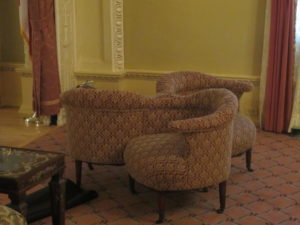 Courtship in the nineteenth century was a carefully-controlled affair, especially among the upper classes like the sphere where Annie Osborn lived. Unmarried women were carefully chaperoned, as this three-way chair in St. Augustine’s Lightner Museum demonstrates.
Courtship in the nineteenth century was a carefully-controlled affair, especially among the upper classes like the sphere where Annie Osborn lived. Unmarried women were carefully chaperoned, as this three-way chair in St. Augustine’s Lightner Museum demonstrates.
Here is a wonderful excerpt from a book I bought in that museum gift store; this is from a chapter entitled “Professor Hill’s Guide to Love and Marriage.”
Any gentleman who may continuously give special, undivided attention to a certain lady is presumed to do so because he prefers her to others. It is reasonable to suppose that others will observe his action. It is also reasonable to be expected that the lady will herself appreciate the fact, and her feelings are likely to become engaged.
Should she allow an intimacy thus to ripen upon the part of the gentleman, and to continue, it is to be expected that he will be encouraged to hope for her hand; and hence it is the duty of both lady and gentleman, if neither intends marriage, to discourage an undue intimacy which may ripen into love, as it is in the highest degree dishonorable to trifle with the affections of another.”
p. 109, The Essential Handbook of Victorian Etiquette, by Professor Thomas E. Hill.
Suppose a man from Kansas were to travel all the way to Martha’s Vineyard to visit a woman who had encouraged him, only to find that she did not trust him with her affections?
Photo by Jeanne Gehret
January 2, 2017
Book Excerpt
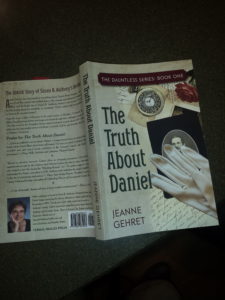 While we’re awaiting shipment of the first copies of The Truth About Daniel, here’s an excerpt from chapter 4 where Daniel and his sister Susan B. Anthony discuss his difficulties with courtship:
While we’re awaiting shipment of the first copies of The Truth About Daniel, here’s an excerpt from chapter 4 where Daniel and his sister Susan B. Anthony discuss his difficulties with courtship:
The Truth About Daniel, by Jeanne Gehret
Excerpt from Chapter 4, Pretense and Disclosure
…From what he knew of her so far, it seemed that Miss Anna Osborn was a good candidate. But he had only a few days to discover whether she might accept him as a suitor. Yes, she was very young. But maybe that was an advantage. The protected life she had led till now left her eager for new experiences, new horizons. That I can provide, for sure!
No doubt Susan would have an opinion on the subject, he thought as he watched her train approach from around the bend. Roaring into the station, it sighed to a stop. Susan, as usual, was the first one off, carrying an alligator purse that appeared heavy, judging from the angle of her arm.
His sister moved through the crowd with efficiency equal to his, for she had traveled more than anyone else he knew. Every hair was in place in the smooth pulled-back style she favored, devoid of flirtatious curls. Sturdily built and forty-three years old, she had a firm jaw and clear, far-seeing eyes that could focus equally well on tiny details. He noted with approval that she was not wearing her black public speaking costume, but something green that blended in better with Saratoga’s resort atmosphere. Maybe the reporters won’t spot her, he hoped.
“What have you got in your bag—gold bricks?” he asked as she kissed him on the cheek.
“Antislavery petitions to circulate in Rochester. And in Saratoga, if I get the chance,” she replied.
“Your letters haven’t mentioned much about women’s rights lately.”
“No. Mr. Garrison and the other antislavery leaders still want us to put all our energies on abolition for now. I disagree, but they assure us that after Congress passes an antislavery amendment, we’ll all work together on woman suffrage. So we go along with him. And how are you, Mr. Mayor? Are you missing your constituents?”
“Well, let’s just say that my desk will be piled high when I return. I don’t know what I was thinking to leave for two weeks in high summer. On the other hand, I don’t know how I thought two weeks would be enough.” He smiled and placed his bulk in front of her to clear a path through the crowd surrounding the baggage cart.
Within an hour he had helped Susan check in to his hotel and deposited her bags in her room before setting off for another stroll. “I’m doing an article on Saratoga, and I’d like you to meet some women I interviewed.” He was counting on his sister’s agreement, since he had already invited the island women to meet her that evening. They seemed impressed.
“When?” asked Susan.
“How about dinner tonight? There are fireworks out by the lake. I booked a table beforehand overlooking the water.”
“Lovely. I’ve never seen Saratoga Lake.” She paused at one end of a long fountain, where a crouching marble figure was spitting water toward a similar figure at the other end. She laughed. “Reminds me of some politicians I’ve known,” she observed, bending to read the nameplate of the sculptures. “‘Spit and Spat.’ How appropriate!” They chuckled.
“The thing is, Susan, I want you to meet Annie. She’s one of the daughters of the women I interviewed.”
Susan cocked her head, interested. “Oh? Does she need help? Or might she assist our reform? Tell me more.”
“She might be good wife material.”
Daniel’s sister frowned at his turn of phrase.
He shrugged. “Sorry. I know women are people, not things. But I am looking for a very special woman, and I don’t have much time. So I have several criteria in mind.”
She would not be appeased. “Blonde or brunette? Short or tall? Strong or fragile? Really, D.R., you don’t pick out a wife like you do a horse.” She stopped dead on the path, causing a pair of strolling women to weave around them.
He took her arm. “Please don’t just stand there. Hear me out.” When she resumed walking by his side, he told her the qualities on the list he had made earlier.
“Well, that’s better,” Susan allowed. “But unless you’re already well-acquainted with this particular woman, you’ll be hard pressed to win her heart in two more days.” She shook her head to emphasize the difficulty of accomplishing such a feat.
“I forgot how stuffy this town is,” he concurred. “Chaperones everywhere. Did you see that courting chair in the lobby?” He had been puzzled, then appalled, when he regarded the ornate piece of furniture that resembled three separate chairs glued together facing each other. How could you ever get to know a woman with a chaperone listening to every word? He had avoided that corner of the lobby all week.
Susan nodded, her air of disapproval fading. “I’m surprised to hear that you, the perennial bachelor, would seek a wife. My, my.” She paused to consider. “Do you think she’ll have you—” she looked at him archly “—even with the Anthony nose?” She pulled a long face as she said this.
He laughed as she had intended, harking back to a time when a young woman had confided to Susan that she might consider marrying D.R. if not for the Anthony nose. “Maybe I better look for a nearsighted woman,” he said.
“Long-distance courting will be difficult,” Susan warned. “Too bad you never found a girl in Rochester, where you could take your time getting to know her.”
He shook his head. “Too many Quaker caps. Can’t pick out a woman without seeing her hair.”
Looking, amused, she continued, “Why haven’t you met anyone in Kansas?”
“Most of the women you meet in Kansas are already married—they’d never set foot there without a husband. It’s too—raw. Still mostly untamed. And the ones who aren’t married—well, most are not the kind of woman I’d want to meet in the light of day.”
Susan looked away as if reflecting on the prostitution problem in the West. “Where’s her home?”
“Martha’s Vineyard. Right across the water from where Fred Douglass lived when he first escaped from the South. She’d have to move to Leavenworth for it to work. I won’t compromise on that.”
“Hmmm.”
D.R. watched as she retied the ribbon of her hat, which looked like a pillow strapped on top of her head. “You know, Suse, even I can see that your hat does nothing for you. Would you like to get a new one before dinner?”
Copyright © 2017 Jeanne Gehret
January 1, 2017
Emancipation Proclamation-What Sort of Freedom
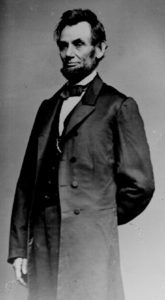 On January 1, 1863, during the Civil War, President Abraham Lincoln issued the Emancipation Proclamation that freed slaves in areas under rebellion.
On January 1, 1863, during the Civil War, President Abraham Lincoln issued the Emancipation Proclamation that freed slaves in areas under rebellion.
Daniel Anthony had finished his military career by this point, but he would have grasped the mixed message that Lincoln was sending. In effect, the president was freeing people whom he did not even control because they were behind enemy lines. However, this may have encouraged African-Americans pressed into Confederate assistance to abandon their posts if they could reach the safety of Union lines, thus weakening the rebel cause. Fewer Southern whites would have been available to fight if they had to do the jobs that black men were forced to do.
Many Northerners, especially Susan B. Anthony, considered this document to have no teeth and pressed for an amendment to the Constitution to permanently outlaw slavery. That went into effect with the Thirteenth Amendment, ratified in December 1865 after the close of the Civil War and the death of Abraham Lincoln.
December 30, 2016
D.R.’s Pugnacious Temperament
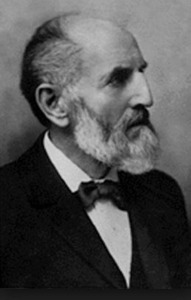 I love the term “pugnacious,” which describes someone just itching for a fight. That seems a fair representation of Daniel Read Anthony of Leavenworth, who was descended from the same stock as Susan B. Anthony. While this brother and sister were both devoted to the abolition of slavery, she fought with words, attempting to change legislation, while he wrote fiery articles and backed them up with bullets. (Besides being a Union colonel and Kansas Jayhawker, he founded a newspaper dynasty whose owners were all named Daniel Read Anthony.)
I love the term “pugnacious,” which describes someone just itching for a fight. That seems a fair representation of Daniel Read Anthony of Leavenworth, who was descended from the same stock as Susan B. Anthony. While this brother and sister were both devoted to the abolition of slavery, she fought with words, attempting to change legislation, while he wrote fiery articles and backed them up with bullets. (Besides being a Union colonel and Kansas Jayhawker, he founded a newspaper dynasty whose owners were all named Daniel Read Anthony.)
Here’s an excerpt from a colorful account of several Kansas editors whose combative natures emphasized their verbal onslaughts:
Dan Anthony I of Leavenworth deserves top billing among the pistol-packing pencil pushers. He fought a duel, was shot at numerous times, was seriously wounded once and killed a rival editor in his own home town. All of these incidents occurred during the territorial or early statehood days, and he carried two big horse pistols for many years and to his dying day these lethal weapons, ready to go, laid on or in the top drawer of his desk. During the later period of forty years he never had occasion to use this armament, but it was well known that “Ole Dan” was always ready. He mellowed a good deal as he grew older and while his likes and dislikes were just as sharply drawn and aggressively supported or opposed he learned to temper his violence materially.
Another significant difference between them is that D.R. married and settled in Leavenworth, KS while Susan remained single and became a citizen of the world. Many years she logged 100 speeches–think of that, two a day–many of them in different towns.
The photo of D.R. above depicts one of his quieter moments. Despite his warlike nature, he died of natural causes at the age of 80. Read about his most deadly encounter in The Truth About Daniel, coming in January.
December 27, 2016
New Book: The Truth About Daniel
Watch this space to order this new historical novel entitled The Truth About Daniel, by Jeanne Gehret, author of this blog. It is the untold story of Susan B. Anthony’s brother and Book One in the Dauntless Series.
Description: Daniel Read Anthony fascinated young, naive, and privileged Annie Osborn: as a Union colonel, he had battled slavery; he had struggled to build a new settlement in the wild West; and he was the brother of her own heroine, Susan B. Anthony. Attracted by his unselfish courage and commanding presence, she nevertheless had doubts. Was he too old? Too businesslike? Too unpredictable to accept as a suitor and eventually as her life partner?
From the fiery conflict of Kansas to the prim parlors of Martha’s Vineyard, from Quaker consciences to whaling captains’ conservatism, The Truth About Daniel portrays lovers who forge new bonds through their willingness to take chances.
This first novel in the Dauntless series weaves historical strands about D.R. Anthony to delve into his improbable choice of bride, a socialite half his age from the whaling capital of Martha’s Vineyard.
Praise for The Truth About Daniel:
“…Gives an authentic voice to Annie Osborn, a young woman from a prominent Edgartown family whose South Water street home still stands. Her story is rooted in Martha’s Vineyard’s recorded past and actual events published in the Vineyard Gazette, the Island’s first newspaper.”—Hilary Wall, Archivist and Librarian, Vineyard Gazette
“Based on extensive research, Gehret offers an intriguing perception of the tribulations experienced not only by the Anthony and Osborn families, but also by many other emigrants who started a new life during the “Bleeding Kansas” era. The author suggests a plausible explanation for Annie’s attraction to D.R. Anthony during this largely-undocumented period of her life and establishes the couple’s rightful place in the era of pioneering exploration.”—Mary Ann Sachse Brown, President, Leavenworth County Historical Society and author of Celebrating Women of Leavenworth County, Kansas.
“…Portrays the attraction between polar opposites and love’s bloom amid strong family objections. The reader is pulled into Annie and D.R.’s story, which occurs in richly-detailed historical settings in Saratoga, NY; the frontier town of Leavenworth, KS; and Annie’s island home on Martha’s Vineyard. A tale of strength, daring and love, it leaves readers wanting more!”—Elaine Lennox, Goodreads Reader
The author is working as fast as she can to finish proofreading and make The Truth About Daniel available the first week in January. Check back often!
December 22, 2016
Victorian Christmas
 Merry Christmas! This festive door from The Rowley House Museum in Williamsport, PA exemplifies the spirit of a Victorian Christmas. From Susan B. Anthony’s letters and biographies, we know that the Rochester Anthonys frequently kept Christmas low-key. (See especially my upcoming post about one of Susan’s most memorable yuletides.) However, the Kansas Anthonys, who enjoyed more affluence, may have hosted celebrations more in keeping with the festive customs sweeping across America.
Merry Christmas! This festive door from The Rowley House Museum in Williamsport, PA exemplifies the spirit of a Victorian Christmas. From Susan B. Anthony’s letters and biographies, we know that the Rochester Anthonys frequently kept Christmas low-key. (See especially my upcoming post about one of Susan’s most memorable yuletides.) However, the Kansas Anthonys, who enjoyed more affluence, may have hosted celebrations more in keeping with the festive customs sweeping across America.
Speaking of the Kansas Anthonys, I am putting finishing touches on my novel about them entitled The Truth About Daniel. Watch this space for how to get it as an e-book in January. In the meantime, holiday blessings!
Click here for an in-depth article on Christmas in the United States. And click here for a look at Britain’s queen who started all the fa-la-la! (On the topic of queens, how accurate is the Netflix series The Crown?)
December 19, 2016
Who Gathered at the Osborns for Christmas?
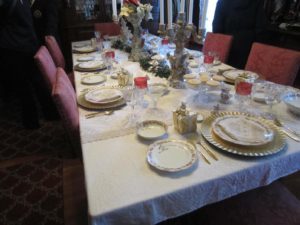 Annie Osborn had ten siblings spanning three decades, since her father was married three
Annie Osborn had ten siblings spanning three decades, since her father was married three
times (widowed twice). Here are some glimpses of who may have joined her on Martha’s Vineyard for her family Christmas in 1863:
Her father, Captain Abraham Osborn, and his wife Ann Eliza (Mayhew)
Her oldest brother Abraham and his fiance Lucy Hobart, who married in 1874 and later went a-whalin’ together
Her sister Eunice Cross and husband Jim, who lived in Milwaukee
Her brother John, who apparently joined the Navy and later visited Annie in Kansas
Her younger sister Mary, who married in 1875 and moved to Brooklyn
It is doubtful that Annie’s finance Daniel Anthony could attend, since he would visit the Vineyard only a month later to marry Annie. This may have been Annie’s last Vineyard Christmas.
All these Osborns appear in my upcoming historical novel entitled The Truth About Daniel. If you have more information about this family, please share it on this blog.
Photo by Jeanne Gehret at The Rowley House Museum, Williamsport, PA
http://SusanBAnthonyFamily.com/
or her brother Daniel Read (D.R.) Anthony. I share all of these on my blog. You can also get special insights into my new b Whenever I travel, I stop in to visit a site connected with Susan B. Anthony
or her brother Daniel Read (D.R.) Anthony. I share all of these on my blog. You can also get special insights into my new book The Truth About Daniel, based on D.R.'s romance and his rambunctious days as an original Kansas Jayhawker ...more
- Jeanne Gehret's profile
- 15 followers


